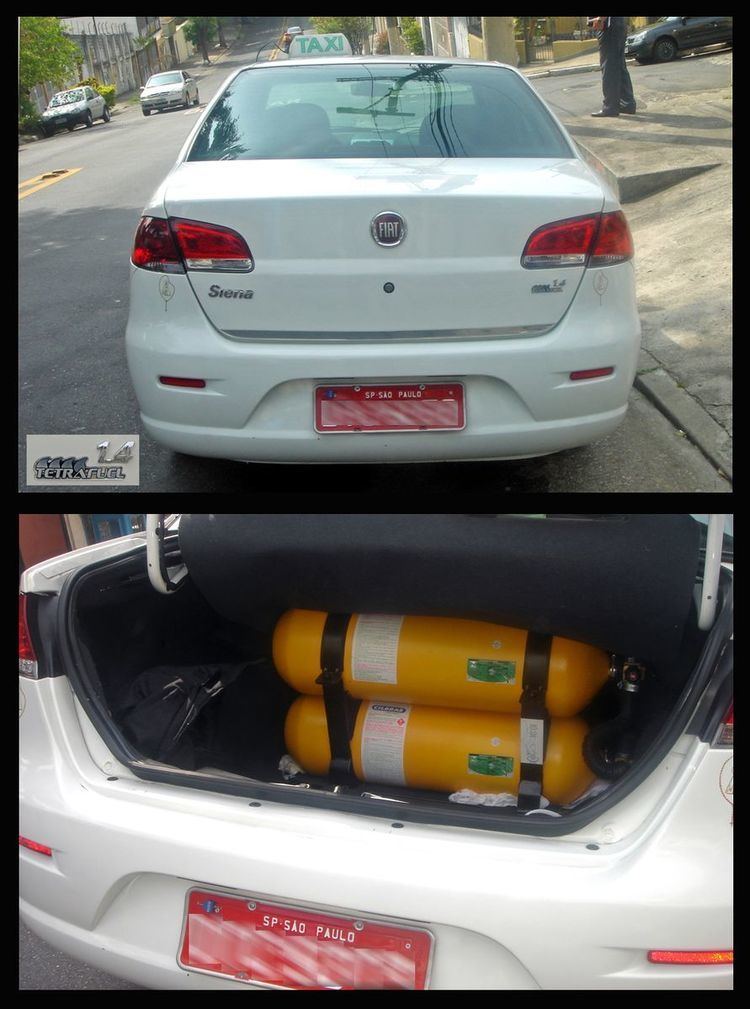 | ||
Bi-fuel vehicles or otherwise known as dual fuel are vehicles with multifuel engines capable of running on two fuels. On internal combustion engines one fuel is gasoline or diesel, and the other is an alternate fuel such as natural gas (CNG), LPG, or hydrogen. The two fuels are stored in separate tanks and the engine runs on one fuel at a time in some cases, in others both fuels are used in unison. Bi-fuel vehicles have the capability to switch back and forth from gasoline or diesel to the other fuel, manually or automatically.
Contents
- Vehicles
- Factory bi fuel passenger cars
- Factory bi fuel pickups
- Low and middle speed conversion
- High speed conversion
- Common conversion features
- Gas types used
- Dieselgas ratio
- References
The most common technology and alternate fuel available in the market for bi-fuel gasoline cars is Autogas (LPG), followed by natural gas (CNG), and it is used mainly in Europe. The Netherlands and the Baltic states have a large number of cars running with LPG. Italy currently has the largest number of CNG vehicles, followed by Sweden. They are also used in South America, where these vehicles are mainly used as taxicabs in main cities of Brazil and Argentina. Normally, standard gasoline vehicles are retrofitted in specialized shops, which involve installing the gas cylinder in the trunk and the LPG or CNG injection system and electronics.
Vehicles
Aftermarket 'bi-fuel' and even 'tri-fuel' conversions are also available.
Factory bi-fuel passenger cars
Factory bi-fuel pickups
Because diesel engines are compression ignition engines, and lack spark plugs, to operate a diesel engine with an alternate combustible fuel source such as Natural gas as the main fuel diesel oil is used for the ignition of the gas/air mixture inside the cylinder (a portion of diesel oil is injected at the end of the compression stroke, thereby maintaining the original diesel operation principle).
Dual fuel operation means the engine uses two fuels (gas and diesel oil) at the same time, as opposed to Bi Fuel which would mean the engine could have the option of using either fuel separately.
There usually two type of conversions - low speed (below 1000 RPM) and high speed (between 1200 and 1800 RPM).
Low and middle speed conversion
Gas is injected into the cylinder inlet manifold by individual gas electromagnetic valves installed as close to the suction valves as possible. The valves are separately timed and controlled by injection control unit. This system interrupts the gas supply to the cylinder during the long overlap of the suction and exhaust valves (just typical for slow-speed and medium-speed engines – within the valve overlap cylinder scavenging is performed). This avoids substantial gas losses and prevents dangerous gas flow to the exhaust manifold.
High speed conversion
Gas is mixed with air by a common mixer installed before turbocharger(s). Gas flow is controlled by a throttle valve, which is electronically operated by the special control system according to the required engine output and speed. In order to avoid knocking of the engine, knocking detector/controller is installed, thus enabling engine operation at the most efficient gas/diesel ratio.
Common conversion features
Gas types used
It is common to use CNG (Compressed Natural Gas) or LNG (Liquid Natural Gas) for bi-fuel operations. Both are also mostly used for Generator sets conversions, because the engine does not lose the output power.
In recent years biogas is being used. The biogas composition and calorific value must be known in order to evaluate if the particular biogas type is suitable. Calorific value may be an issue as biogas is derived from different sources and there is low calorific value in many cases. You can imagine you have to inject sufficient volume of gas into the cylinder to substitute diesel oil (or, better to say, substitute energy delivered by diesel oil). If the calorific value (energy) of the biogas was very low, there is a need to inject really big volume of biogas into the cylinder, which might be technically impossible. Additionally, the composition of the biogas has to lean towards ignitable gases and be filtered as much as possible of uncombustible compounds such as CO2.
Associated gas is the last type of gas which is commonly used for bi-fuel conversions of generator sets. Associated gas is a natural gas found in association with oil, either dissolved in the oil or as a cap of free gas above the oil. It means it has almost the same quality as CNG or LNG.
Diesel/gas ratio
It depends on the technical state of the engine, especially of the injection system. The typical Diesel / Gas ratio is 40/60% for the high-speed engines. If the operating output of the engine is constant and between 70-80% of nominal output, than it is possible to reach up to 30/70% ratio. If the operating output is lower (for example 50% of the nominal output) or if there are variations, the rate is about 45/55% (more of diesel is used).For Low Speed conversions it is possible to reach the Diesel/gas ratio up to 10/90%. Generally, it is not possible to guarantee an exact diesel/gas ratio without a test being done after the conversion.
